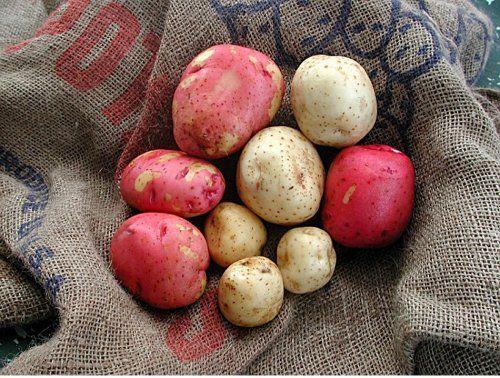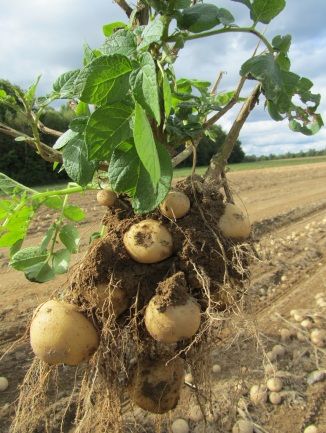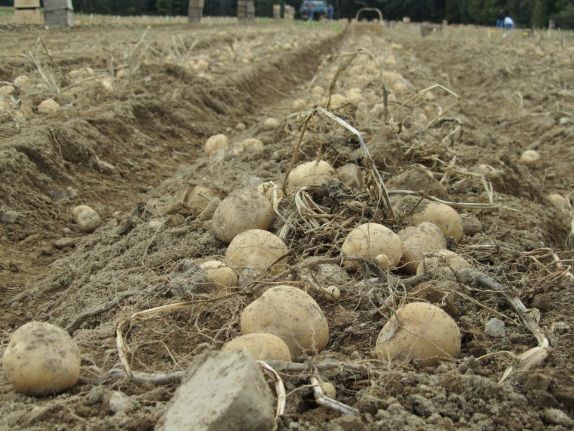Looking to add a nutritional powerhouse to your early season garden this year? One plant that is often thought to be difficult to grow in Florida will surprise many home gardeners. This plant has a long, storied history, having been introduced extensively worldwide, and has invigorated and decimated entire populations. I speak, of course, of the humble potato (Solanum tuberosum), which performs well in our cooler North Florida winter. This member of the Solanaceae or nightshade family can trace its origins to the Andes mountains, where it was discovered by European settlers and brought back to their countries of origin. From there, the potato found success as a food crop and was reintroduced worldwide. This tuber is a big producer, and worthy of a spot in your home garden.
Varieties
The first objective with potatoes is to find a variety that will perform well in our sandy soils and climate. Russets are thought to be the gold standard in potatoes, and while some may be suitable, they are not optimal for Florida gardens. Instead look for some of the later entrants to this market. Several white and red varieties are available which mature quickly and can tolerate environmental conditions in the panhandle. White varieties suitable for this region are ‘Lachipper’ and ‘Sebago’, while the red varieties known to do well here are ‘Red Lasoda’ and ‘LaRouge’. These are compatible with our environment and as such perform well here.

Growth Practices
A well-draining, slightly acidic, and loose soil will provide the best environment for maximum yield. As with all gardening, it’s best to have your soil tested well before you plant and make any pH adjustments required early. Potatoes grow from “seed” which are essentially smaller potatoes grown specifically to produce more plants. It’s best to acquire these from a reputable seller and avoid grocery store leftovers, as their variety and disease resistance is questionable. Growth happens from the “eye” of the seed, which may be planted with or without growing roots. Cut the seeds into smaller pieces, ensuring there is at least one eye per piece, and allow them to sit in a cool, dark environment for a few days to callous over. They are now ready to plant and should be four inches deep, spaced eight inches apart in three-foot rows. Potatoes require two fertilizer applications, emphasizing nitrogen and potassium specifically, as these pass through the soil easily with irrigation. Apply half of the fertilizer at planting with another application approximately 30-40 days later. Application rates vary and are based on yield goals as well as soil test results so check with your local extension agent to discuss application rates. Keep the potatoes evenly moist but make sure not to flood the rows. Finally, there is a unique methodology with potatoes in that you’ll need to add soil to the top of the row when the potatoes poke through. This is called hilling and is crucial to keep the tubers from turning green and producing a toxin known as solanine.

Harvest Time
Your potatoes should be harvestable in about 90-105 days, depending on variety and environmental factors. You’ll be able to tell the plant has matured as the vines will begin to die back naturally. Modern practices have augmented this to include a vine kill which may be performed mechanically or through chemical application. This will force the tubers to mature, allowing the gardener greater control of harvest times and helping to avoid the risk of late-season pathogens. Vine kills are performed between 80-90 days after planting with tubers remaining in the ground for an additional 21 days. All of these time frames are dependent on variety but will produce a more usable and easy-to-store tuber.

Potatoes are a worthy addition to the garden and can provide a lot of nutrient-dense food in a small space. There are a few tricks to growing these tubers, but for what they give back, you’ll find it a very rewarding experience. For more information, see these Ask IFAS documents. As always, please contact your local extension agent for additional information on this and any topic regarding your gardens and more.
- Cold Protection for North Florida - November 6, 2025
- Planning and Planting for Wildlife - October 10, 2025
- Why Say No to Invasive Species - August 23, 2025
